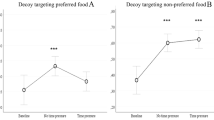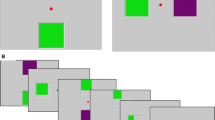Abstract
The asymmetric dominance effect (ADE) occurs when the introduction of a partially dominated decoy option increases the choice share of its dominating alternative. The ADE is a violation of regularity and the constant-ratio rule, which are two derivations of the independence of irrelevant alternatives axiom, a core tenant of rational choice. The ADE is one of the most widely reported human choice phenomena, leading researchers to probe its origins by studying a variety of non-human species. We examined the ADE in brown capuchin monkeys (Cebus apella), a species that displays many other decision biases. In Experiment 1, we used a touchscreen method to elicit choice-based preferences for food rewards in asymmetrically dominated choice sets. In Experiments 2 and 3, we distinguished between different types of judgments and used a free selection task to elicit consumption-based preferences for juice rewards. However, we found no evidence for the ADE through violations of regularity or the constant-ratio rule, despite the similarity of our stimuli to other human and non-human experiments. While these results appear to conflict with existing literature on the ADE in non-human species, we point out methodological differences—notably, the distinction between value-based and perception-based stimuli—that have led to a collection of phenomena that are difficult to understand under a unitary theoretical framework. In particular, we highlight key differences between the human and non-human research and provide a series of steps that researchers could take to better understand the ADE.





Similar content being viewed by others
Notes
Due to experimenter error, participant MP did not complete training session 4 but participated in the main experiment. Her performance did not differ from other participants.
References
Ariely D, Wallsten TS (1995) Seeking subjective dominance in multidimensional space: an explanation of the asymmetric dominance effect. Organ Behav Hum Decis Process 63:223–232
Bateson M, Kacelnik A (1998) Risk-sensitive foraging: decision making in variable environments. In: Dukas R (ed) Cognitive ecology. Chicago University Press, Chicago, pp 297–341
Bateson M, Healy SD, Hurly TA (2002) Irrational choices in hummingbird foraging behaviour. Anim Behav 63:587–596
Bateson M, Healy SD, Hurly TA (2003) Context-dependent foraging decisions in rufous hummingbirds. Proc R Soc Lond B Biol Sci 270:1271–1276
Baumeister RF, Bratslavsky E, Muraven M, Tice DM (1998) Ego depletion: is the active self a limited resource? J Personal Soc Psychol 74:1252–1265
Brosnan SF, de Waal FBM (2003) Monkeys reject unequal pay. Nature 425:297–299
Chen MK, Lakshminarayanan V, Santos LR (2006) How basic are behavioral biases? Evidence from capuchin monkey trading behavior. J Polit Econ 114:517–537
Cuthill IC, Maddocks SA, Weall CV, Jones EK (2000) Body mass regulation in response to changes in feeding predictability and overnight energy expenditure. Behav Ecol 11:189–195
Dhar R, Glazer R (1996) Similarity in context: cognitive representation and violation of preference and perceptual invariance in consumer choice. Organ Behav Hum Decis Process 67:280–293
Doyle JR, O’Connor DJ, Reynolds GM, Bottomley PA (1999) The robustness of the asymmetrically dominated effect: buying frames, phantom alternatives, and in-store purchases. Psychol Market 16:225–243
Edwards SC, Pratt SC (2009) Rationality in collective decision-making by ant colonies. Proc R Soc Lond B Biol Sci 276:3655–3661
Egan LC, Santos LR, Bloom P (2007) The origins of cognitive dissonance evidence from children and monkeys. Psychol Sci 8:978–983
Egan LC, Bloom P, Santos LR (2010) Choice-induced preferences in the absence of choice: evidence from a blind two choice paradigm with young children and capuchin monkeys. J Exp Soc Psychol 46:204–207
Estle SJ, Green L, Myerson J, Holt DD (2007) Discounting of monetary and directly consumable rewards. Psychol Sci 18:58–63
Fragaszy DM, Visalberghi E, Fedigan LM (2004) The complete capuchin. Cambridge University Press, Cambridge
Frederick S, Lee L, Baskin E (2014) The limits of attraction. J Market Res 51:487–507
Heyman J, Ariely D (2004) Effort for payment. Psychol Sci 15:787–793
Huber J, Payne JW, Puto C (1982) Adding asymmetrically dominated alternatives: violations of regularity and the similarity hypothesis. J Consum Res 9:90–98
Hurly TA, Oseen MD (1999) Context-dependent, risk-sensitive foraging preferences in wild rufous humming birds. Anim Behav 58:59–66
Jacobs GH (1999) Prospects for trichromatic color vision in male Cebus monkeys. Behav Brain Res 101:109–112
Lakshminarayanan VR, Chen MK, Santos LR (2008) Endowment effect in capuchin monkeys (Cebus apella). Philos Trans R Soc B 363:3837–3844
Lakshminarayanan VR, Chen MK, Santos LR (2011) The evolution of decision-making under risk: framing effects in monkey risk preferences. J Exp Soc Psychol 47:689–693
Latty T, Beekman M (2010) Irrational decision-making in an amoeboid organism: transitivity and context-dependent preferences. Proc R Soc Lond B Biol Sci 278:307–312
Lea SE, Webley P (2006) Money as tool, money as drug: the biological psychology of a strong incentive. Behav Brain Sci 29:161–175
Loftus GR (1996) Psychology will be a much better science when we change the way we analyze data. Curr Dir Psychol Sci 5:161–171
Luce RD (1959) Individual choice behavior: a theoretical analysis. Wiley, New York
Morgan KV, Hurly TA, Bateson M, Asher L, Healy SD (2012) Context-dependent decisions among options varying in a single dimension. Behav Process 89:115–120
Parrish AE, Evans TA, Beran MJ (2015) Rhesus macaques (Macaca mulatta) exhibit the decoy effect in a perceptual discrimination task. Atten Percept Psychophys 77:1715–1725
Pettibone JC, Wedell DH (2000) Examining models of nondominated decoy effects across judgment and choice. Organ Behav Hum Decis Process 81:300–328
Pocheptsova A, Amir O, Dhar R, Baumeister RF (2009) Deciding without resources: resource depletion and choice in context. J Market Res 46:344–355
Ratneshwar S, Shocker AD, Stewart DW (1987) Toward understanding the attraction effect: the implications of product stimulus meaningfulness and familiarity. J Consum Res 13:520–533
Raubenheimer D, Simpson SJ (1997) Integrative models of nutrient balancing: application to insects and vertebrates. Nutr Res Rev 10:151–179
Rosati AG, Stevens JR, Hare B, Hauser MD (2007) The evolutionary origins of human patience: temporal preferences in chimpanzees, bonobos, and human adults. Curr Biol 17:1663–1668
Rozin P, Millman L, Nemeroff C (1986) Operation of the laws of sympathetic magic in disgust and other domains. J Personal Soc Psychol 50:703–712
Rozin P, Haidt J, McCauley CR (2000) Disgust. In: Lewis M, Haviland-Jones JM (eds) Handbook of emotions, 2nd edn. Guilford Press, New York, pp 637–653
Santos LR, Chen KM (2009) The evolution of rational and irrational economic behavior: evidence and insight from a non-human primate species. In: Glimcher PW, Fehr E, Camerer C, Poldrack RA (eds) Neuroeconomics: decision making and the brain. Academic Press, Waltham, pp 81–93
Santos LR, Rosati AG (2015) The evolutionary roots of human decision-making. Annu Rev Psychol 66:321–347
Santos LR, Hauser MD, Spelke ES (2001) Recognition and categorization of biologically significant objects by rhesus monkeys (Macaca mulatta): the domain of food. Cognition 82:27–155
Santos LR, Sulkowski GM, Spaepen GM, Hauser MD (2002) Object individuation using property/kind information in rhesus macaques (Macaca mulatta). Cognition 83:241–264
Scarpi D (2011) The impact of phantom decoys on choices in cats. Anim Cogn 14:127–136
Schuck-Paim C, Pompilio L, Kacelnik A (2004) State-dependent decisions cause apparent violations of rationality in animal choice. PLoS Biol 2:2305–2315
Shafir S (1994) Intransitivity of preferences in honey bees: support for comparative evaluation of foraging options. Anim Behav 48:55–67
Shafir EB, Osherson DN, Smith EE (1989) An advantage model of choice. J Behav Decis Making 2:1–23
Shafir S, Waite TA, Smith BH (2002) Context-dependent violations of rational choice in honeybees (Apis mellifera) and gray jays (Perisoreus canadensis). Behav Ecol Sociobiol 51:180–187
Shutts K, Condry KF, Santos LR, Spelke ES (2009) Core knowledge and its limits: the domain of food. Cognition 112:120–140
Simonson I (1989) Choice based on reasons: the case of attraction and compromise effects. J Consum Res 16:158–174
Simonson I, Tversky A (1992) Choice in context: tradeoff contrast and extremeness aversion. J Market Res 29:281–295
Trueblood JS, Brown SD, Heathcote A, Busemeyer JR (2013) Not just for consumers: context effects are fundamental to decision making. Psychol Sci 15(24):901–908
Tversky A (1969) Intransitivity of preferences. Psychol Rev 76:31–48
Tversky A, Simonson I (1993) Context-dependent preferences. Manage Sci 39:1179–1189
Vohs KD, Mead NL, Goode MR (2006) The psychological consequences of money. Science 314:1154–1156
Waite TA (2001) Intransitive preferences in hoarding gray jays (Perisoreus canadensis). Behav Ecol Sociobiol 50:116–121
Wedell DH (1991) Distinguishing among models of contextually induced preference reversals. J Exp Psychol Learn 17:767–778
Wedell DH, Pettibone JC (1996) Using judgments to understand decoy effects in choice. Organ Behav Hum Decis Process 67:326–344
Yang S, Lynn M (2014) More evidence challenging the robustness and usefulness of the attraction affect. J Market Res 51:508–513
Acknowledgements
The authors wish to thank Jane Wildness, Melissa Baranay, Cam Cullman, Linda Chang, Nick Buttrick, Molly Lucas, Lars Knudsen, Sarah Sentmore, Matthew Roth, Angie Johnston, and Ellen Furlong for their help in running these studies. We also thank Shane Frederick for his help in working through the results of this study. This research was supported by Yale University and a McDonnell Scholar Award to L.R.S.
Author information
Authors and Affiliations
Corresponding author
Ethics declarations
Conflict of interest
The authors declare that they have no conflict of interest.
Ethical approval
This research was conducted in compliance with federal laws of the USA and with the regulations of Yale University. The protocol for non-human primates was approved by the Institutional Animal Care and Use Committee at Yale University (Protocol Number: #2008-10678).
Rights and permissions
About this article
Cite this article
Cohen, P.M., Santos, L.R. Capuchins (Cebus apella) fail to show an asymmetric dominance effect. Anim Cogn 20, 331–345 (2017). https://doi.org/10.1007/s10071-016-1055-5
Received:
Revised:
Accepted:
Published:
Issue Date:
DOI: https://doi.org/10.1007/s10071-016-1055-5




